Axel Tritton & James Davidson climb The Shield VI 5.9 A3+ 06.02.18
The following article was written by Axel Tritton and gives some awesome detail into his and James Davidson's climb of The Shield on El Capitan late last year. The Shield is one of the iconic routes of El Cap and heads straight up it's most exposed headwall. These two fellas are absolute phenomenal local climbers and us at Mountain Equipment and, we're sure the whole Bluey's climbing community, are super proud of both of them. If an ascent like this wasn't enough to justify a trip to Yosemite, they backed it up a couple days later with an ascent of the Nose in just over 6 hours. Both Axel and James are quite understated and you won't here them promoting themselves too much but if you bump into them at the crag make sure you say a big g'day and a high five. We also want to thank Axel for writing and letting us post this article. - Matt Eaton
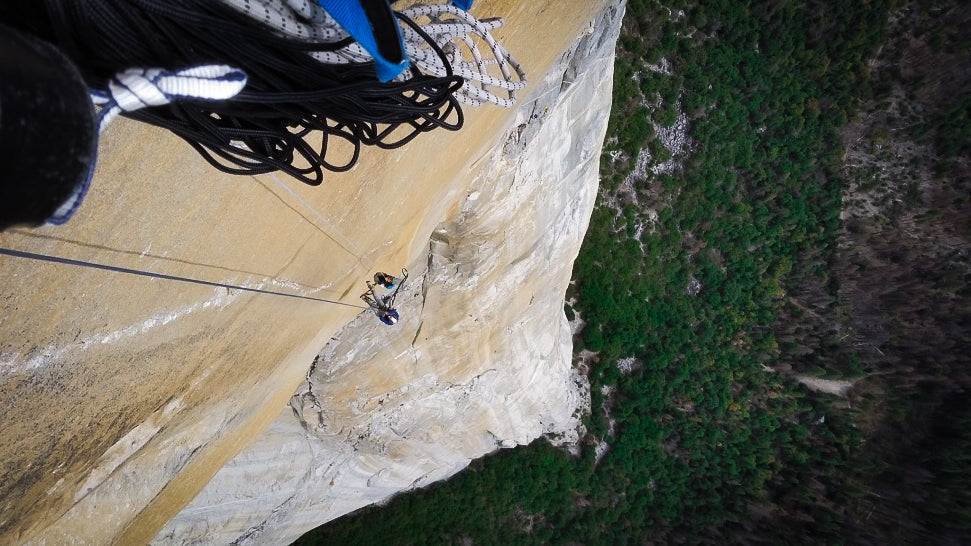
It was nearing the end of what was another great trip to the states in mid-October 2017. Scotty, Carl, Amie, James, Claire and I had been road tripping through the United States, attended the world-renowned Burning Man festival, a short time in Las Vegas doing “the tourist thing” and climbing and canyoneering in Zion National park where Scotty and I climbed the iconic “Moonlight Buttress” and we also did the classic Zion “Keyhole” and “Pine Creek” canyons.
We then made our way back to Yosemite National park, The Centre of the Universe.
We had been climbing in the Valley and up in Tuolumne Meadows for a few weeks ticking off single and multi-pitch routes whilst enjoying the presence and zenquility of being in such a beautiful and meaningful place doing what we love.
Unfortunately Claire had to go back to aussie land and the gang of now five had just come down from a 3.5 day ascent of “The Triple Direct”, the first big-wall for Amie, Scotty and Carl. Amie’s time in the states had now come to an end too, which just left the four of us in the valley. James and I now set our sights on El Capitan’s iconic big-wall “The Shield”.
The Shield is a 30 pitch 2,900ft A3 grade VI big-wall originally put up by Charlie Porter and Gary Boarde in 1972. The route follows a path on the southwest face of El Capitan climbing over some of the steepest and most outrageously exposed terrain the cliff has to offer. James and I were eager to try and climb it!
Despite having limited experience with aid climbing, with the exception of me climbing The Zodiac back in 2013 with my buddy Joe Marlay. James and I played around with some bird beaks on the boulders near the campsite a few days earlier, what the heck we decided to have a crack!
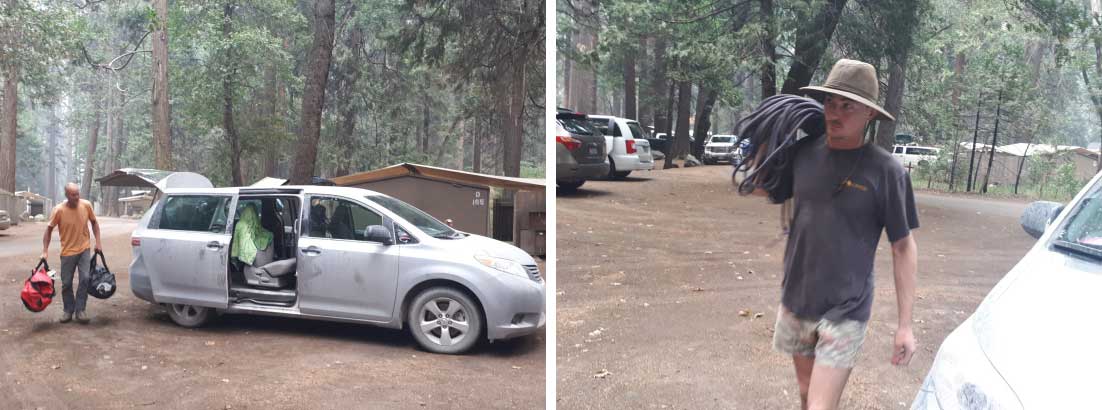
We spent a few days procrastinating, fearful that what we were undertaking was above our level of capability in the aid-climbing world, considering our inexperience on such routes. But we both knew that having a pessimistic attitude was definitely not going to get us very far in this sport of big wall climbing.
So we racked our gear and sorted our supplies for the 5 days we intended to be on the wall and made our way down to El Capitan where the Shield stands tall and looms ominously dominating the view above the meadows.
I went over to where infamous Yosemite big-wall photographer Tom Evans perches himself in the meadow, observing and taking long range photos of the climbers on the wall with a large telescopic lens on his camera. I told him that we are about to set off on ‘The Shield’ to which he replied that this particular route is one of his favourite routes to shoot and he would gladly take photos of us.

It was around 1pm and there was a party of two at the “Shield roof” which is around half way up the route. James and I started humping heavy climbing loads to the base of the route with the generous help of Scotty and Carl. We packed the haul bags, clipping them all together including, the portaledge, and poop tube connecting them to the haul line with a sawn off bottle top to protect the Knot. We blew kisses and said our goodbyes to Scotty and Carl and started ascending the old weathered, core-shot, fixed lines that lead up to Mammoth Terraces, 10 pitches up, around 300meters from the ground, where the route officially starts, pulling all our gear up using a 2:1 hauling system while the seconder counterweights the haul line.
We had two (150 L) haulbags filled to the brim with all our food, water, sleeping gear and clothing, one double portaledge, one poop tube, and all our climbing gear, a triple rack of totem cams, 10 beaks, assorted pins, knifeblades, rurps, hooks, rivet hangers, regular and brass nuts, alpine draws, two sets of jumars and etriers and 190m of rope. One haul line (60m), one lead line (60m), one 6mm tag line (60m) and a lower out line to stow and lower out the bags (10m), and god knows how many locking and non-locking carabiners.
We made it to the Mammoth Terraces in good time and pushed on up a few pitches to “The Grey Ledges” where we settled in for the night. We heated up some minestrone soup enjoying it with classic American bagels and then sorted our sleeping arrangements.
Well going to the toilet on a big wall can definitely be quiet an ordeal at times, particularly if the matter does not have much density to it and James was definitely experiencing this issue on the first night. We use wag-bags, a zip lock bag complete with toilet paper and hand sanitizer which then is stored in the poop tube, a 600mm pvc pipe with a screw cap lid. One can only hold their breath for so long when the screw cap if off the poop tube.
Morning and our second day on the wall, Breakfast is a can of mixed fruit each while we sit there and ponder life looking over the valley floor. We also spent some time organising ourselves for the pitches ahead of us. We finally got moving again making our way towards the “The Shield Roof” James having led a series of tricky A2 traversing pitches we found ourselves underneath “The Shield Roof” and it was my turn to lead again. The weather was dead calm and the roof didn’t look that technical, just steep, lots of bolts with hangers and fixed gear. I made my way through it with no issues and pulled onto the Shield Headwall where the route character suddenly changes dramatically. The wall becomes 10 degrees overhung and then the wind howls across the headwall and you’re screaming at your partner to communicate. Any retreat from this point onwards would have been extremely difficult and somewhat time consuming.
James and I began a methodical process of setting up, hauling and cleaning belays without the need to talk, verbal or visual communication was not possible above “The Shield Roof”.
The climbing from this point onwards was steep, tricky and precarious, with lots of insecure placements. We both found ourselves in situations, on lead, where we were standing high up in our etriers committing to the next piece for upwards progression only to have it suddenly rip out from the wall and send us plummeting towards the ground until the rope came tight on the belay to arrest the fall.
It definitely scares the living shit out of you both, climber and belayer, however it also pushes you into a state of hyper awareness, which allows you to pull back up and keep persevering.
We finished the day at the “The Hang” a well bolted hanging belay to accommodate our portalege and haul bags for the 2nd night’s stay. We set up our ledge with the rain fly to shelter us from the wind, threw all our sleeping gear and food inside and then we climbed in. We heated up some long-awaited food as we sat there, on a double ripstop 420d nylon tensioned floor suspended 700 meters above the Yosemite valley floor with just a few 10mm bolts from oblivion.
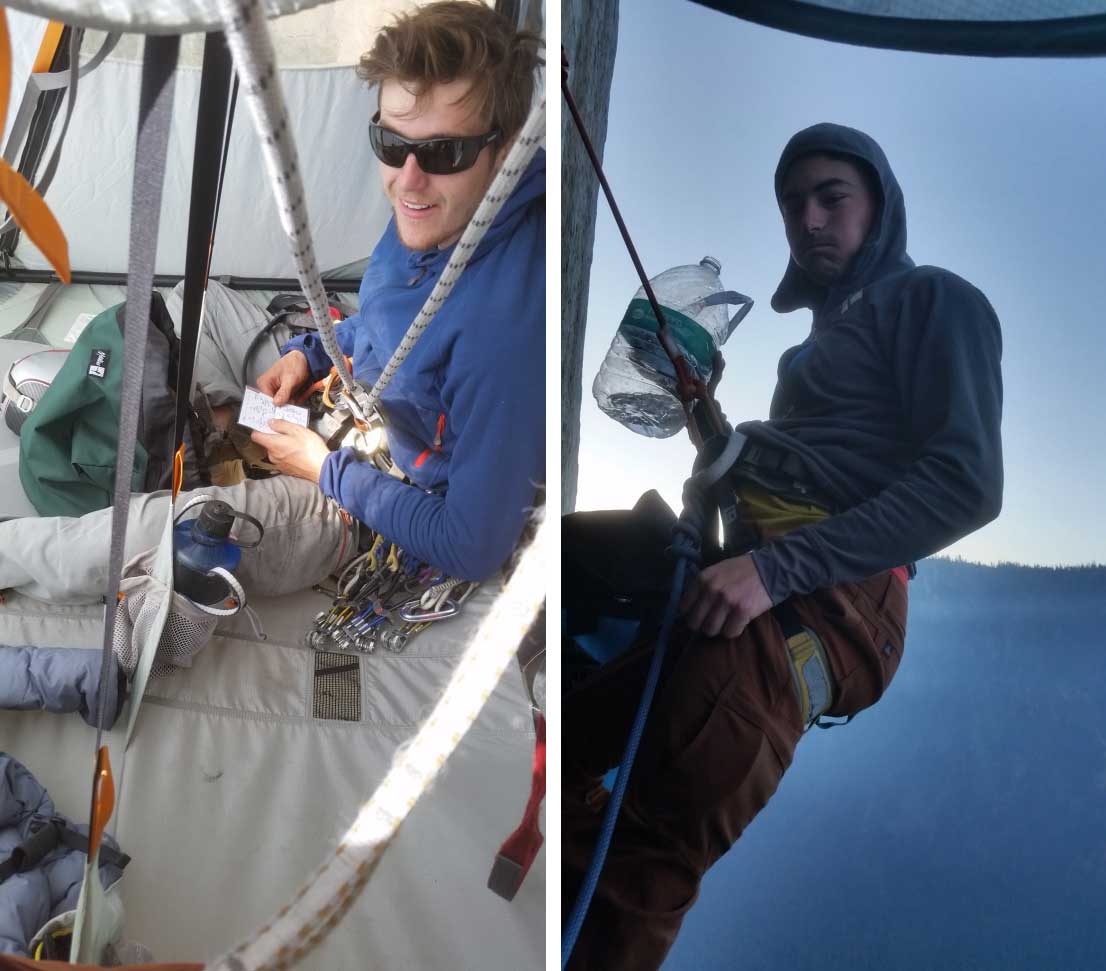
We had almost caught up with the other party and we could hear their voices only a few pitches above. They had arrived at their bivy late into the night and were having difficulty setting up their portaledge. James and I sat there trying to get to sleep listening intently to their struggles and arguments until they too finally settled down.
It was now early morning on The Shield headwall, the wind was calm and the air was crisp. The sun rose around the corner providing pleasant shade throughout the early morning, so it was perfect conditions to try and tackle what is perceived as the crux pitches of the route. “The Triple Cracks”! A series of A3 pitches that follow a thin seam riddled with flared pin scars, beak placements and the occasional fixed rurp and copperhead
James opted to embrace these pitches for all of the eternal glory they had to offer. We toasted some nutella bagels, had a quick glance at the topo then racked up and sorted the belay. We had decided to leave the ledge and haulbags here while we ventured into what was uncharted and daunting territory for us, fixing our ropes as far as they would allow us. James was tied into the sharp end, ready to charge, while I stayed back at “The Hang”, on belay and guarding the fort.
It was a small beak placement straight off the bat, James gave it a light tap with the hammer then slowly transferred his weight onto it from the belay. He said “it looks pretty bomber man” so I replied “yeah no worries shagger, keep cracking on then mate” and that he did, high stepping in his etriers. After many accumulative precarious and sketchy body weight placements he finally made it to a fixed bolt around 10 meters above the belay. We decided to put a locking carabiner on both ends of this quickdraw, – to help prevent the rope unclipping and potentially zippering the entire pitch and shock loading the belay with a massive factor 2 fall. James remained calm, and collected as he continued up the blank face executing each placement with increasing experience and diligence.

Though it was a warm and sunny day the headwall gets quiet cold with a wind chill forcing you to rug up with a big puffy jacket. The wind had now picked up and each wind gust lifted the portaledge up and away from the wall then slammed it back down with a loud bang. There was nothing we could, so I just tried to ignore it while managing the rope in the now horrendous winds.
Before we knew it the “triple cracks” had come to an end and the crux was behind us, smooth sailing now ahead. We had caught up with the party above but had run out of rope to keep pushing on, so we decided to rappel back down to the bivy ledge. Surprisingly our portaledge and haul bags were still connected to the wall and intact so we climbed into the portaledge and zipped up the door. We got a bite to eat while contemplating how to pack up all our gear in this relentless wind. In the end there was no real strategy just a good o’ll wrestle while swinging around on our gri-gri’s until we finally got everything back in their respective bags.
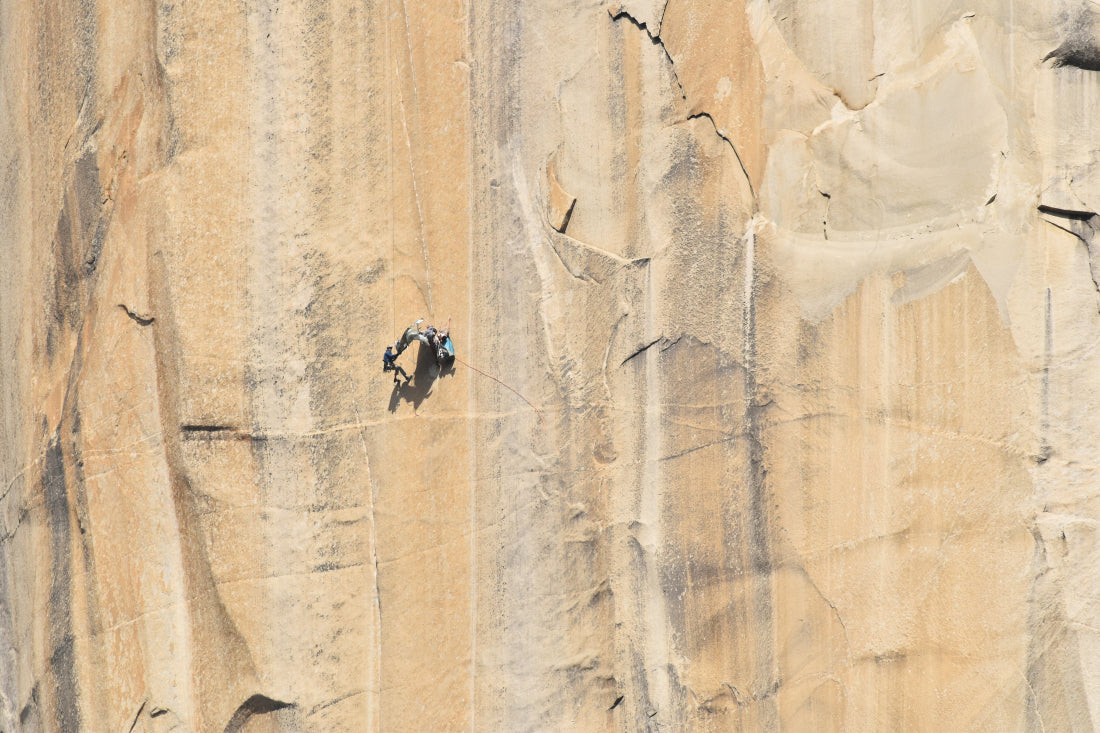
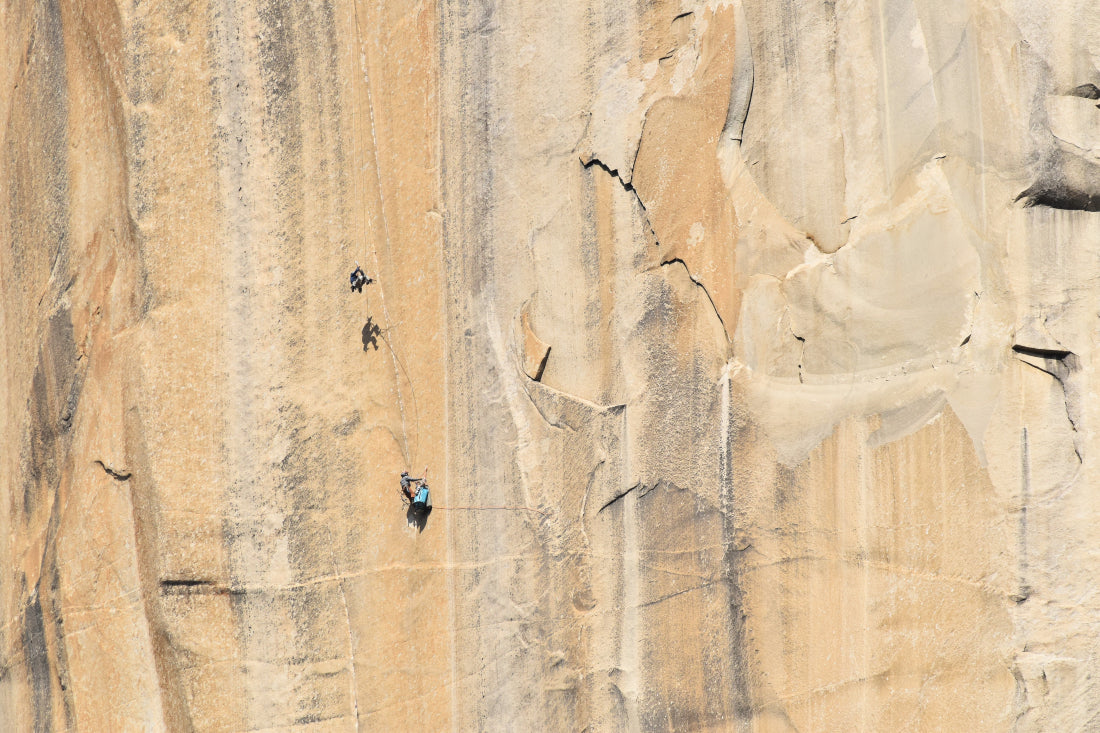
James then jumared back up our fixed haul line and pulled it tight through the mini traxion taking up the weight of the haul bags. I cleaned the belay then sat on the bags and lowered myself away from the wall far out into free hanging space, and then I began to jumar the tensioned line, feeling the bounce from the heavy bags in every upward push.
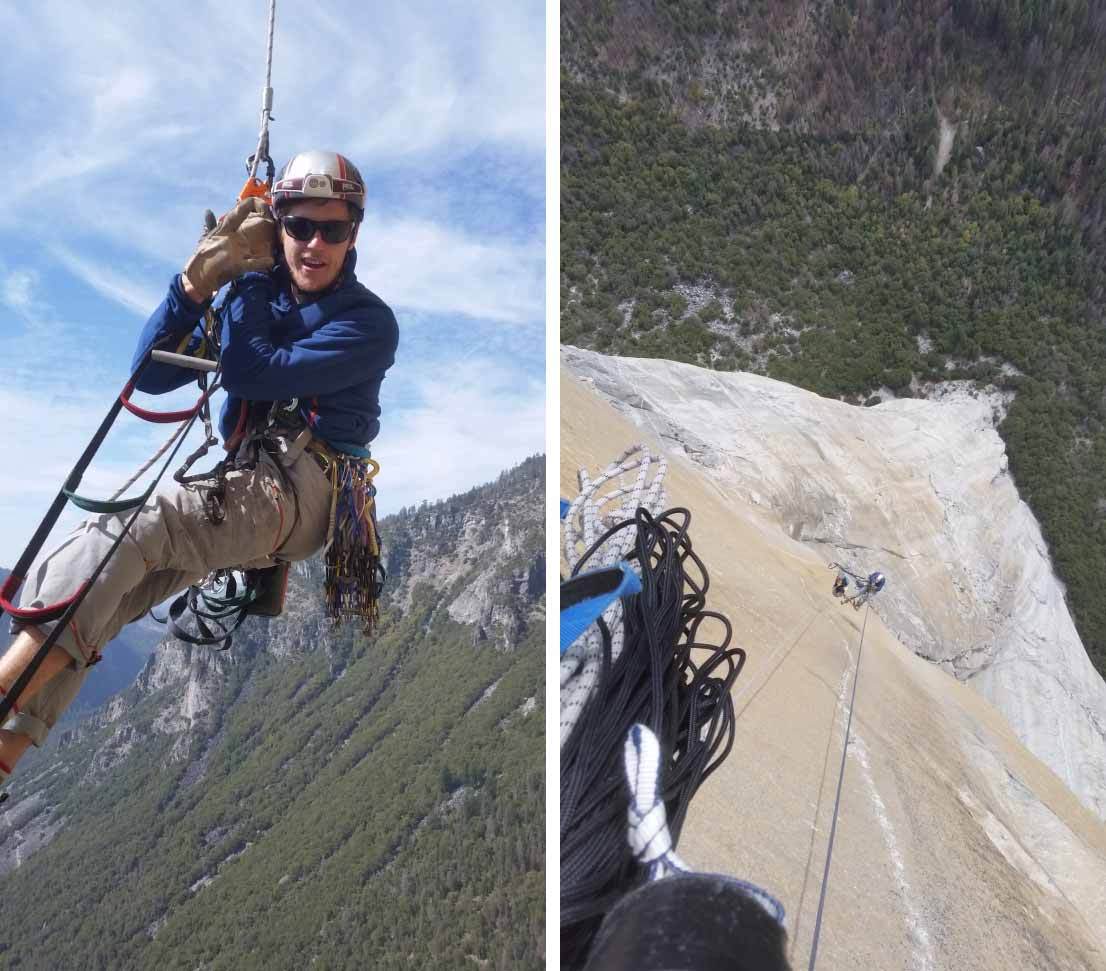
A female team of two were attempting a speed record around the corner on “The Nose” route and the leader had taken a bad fall from the boot flake, she was not in good shape and YOSAR (Yosemite Search And Rescue) had been called in with the helicopter to stabilise her and then safely retrieve her from the wall.
Once I reached James at the belay we hauled up the bags and pushed on up to reach our high point. The climbing eased from here and we made it to the “Chickenhead Ledge” a 10m x 1m sloping ledge where we caught up with the party that was ahead of us..
One was an American Geologist from the USA and the other was originally South African now from Canada. We quickly fixed one more pitch from the Chickenhead Ledge for a quick start the next morning then settled down in our portaledge for another night, the ground was unsuitable to sleep on with all the chickenheads everywhere. But this time we could strip the gear from our harnesses and walk around like we were on the moon, as this was the first piece of solid ground we had encountered in two days.
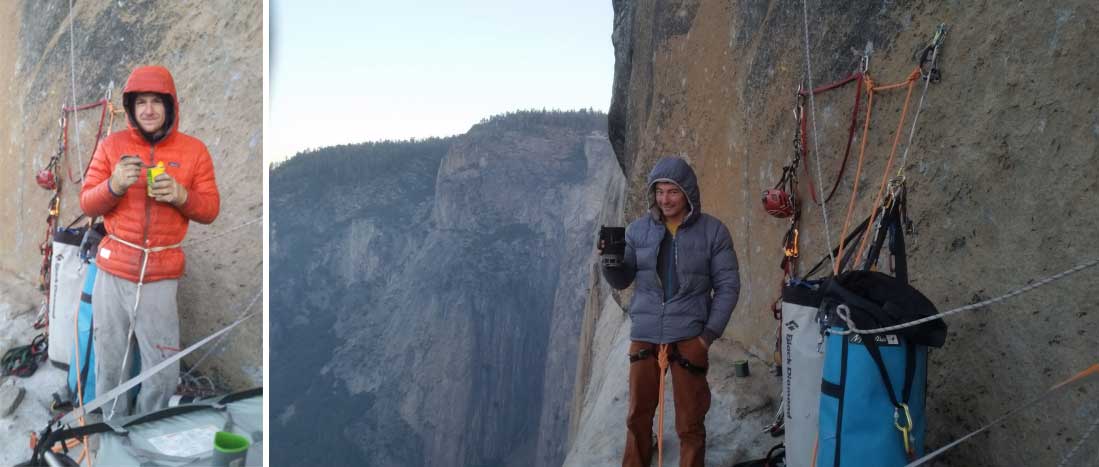
The guys offered us some extra sachets of instant coffee and we didn’t hesitate to accept their offer. Everyone then settled down for another nights rest.
It was now morning and the beginning of day four. The other party was behind us, so there was a clear run to the finish line. The climbing was fairly easy but with the odd tricky pitch or two. We finished up a large 5.7 slot gully to some 4th class scrambling where we transitioned from the “vertical world” into the more horizontal “normal world”. We hauled the bags up from a large tree near the top of El Capitan then released ourselves from the aluminum and steel that was hanging from our waists.
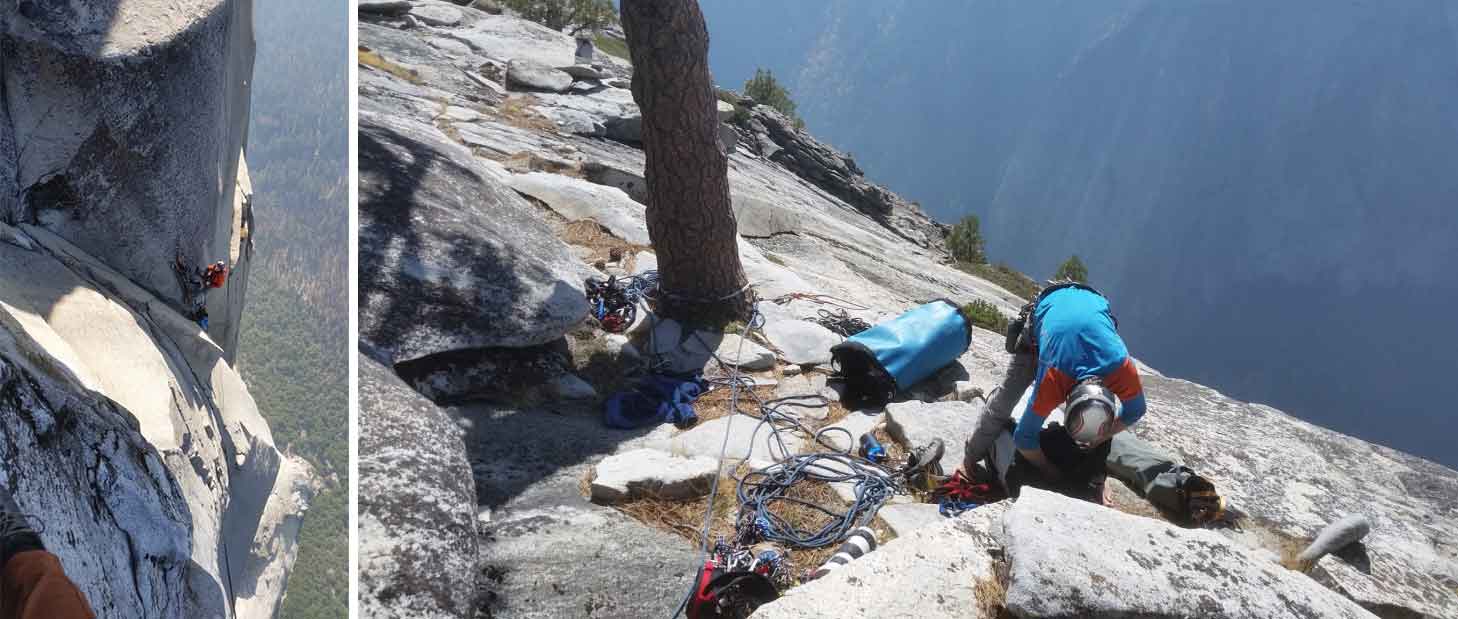
The summit of El Capitan is a secluded place, you generally only run into people who have just successfully topped out on the climbing routes or those that hike up to abseil down to work the upper pitches on free routes.
James and I were keen to get back to the valley floor before dark and before the Pizza Deck restaurant closed so we coiled our ropes, packed away all the gear and started walking down off El Capitan via the “East Ledges Descent”. This is a very steep trail that follows sporadically placed rock cairns down polished slabs and through Manzanita tree mazes followed then by a series of rappels. We arrived back at the carpark about 3 hours later to what was the finish line of an unforgettable 4 days of collaborative climbing effort on one of the most spectacular routes on El Capitan.
To our surprise Scotty and Carl were having lunch at a picnic table and we ran straight into them, just by coincidence, and our “brush with fame” moment was Tommy Caldwell (professional climber) casually riding his bike around the carpark with his son on the back.
Scotty and Carl had to leave for San Francisco and James and I climbed the NIAD (Nose In A Day) a few days later in 8.2 hours (but that is another story), then I set off for San Francisco and then headed home to Aussie land. Lucky James pushed on to Indian Creek for a few weeks climbing in the desert.
It was an awesome trip filled with unforgettable experiences that we will be reminiscing about for years to come.
I can’t wait to go back!
Axel Tritton
